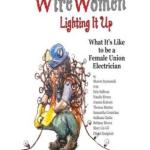What It’s Like To Be a Female Union Electrician – A Review of Wirewomen: Lighting It Up

There is an importance to that, for women, for society and especially for young girls who can imagine a future for themselves that would have been inconceivable 50 years. Children’s books feature heroines, successful entrepreneurs, singers, athletes, engineers, kids independent in thought, able to navigate the world.
“Wire Women come from many different backgrounds and are of all diverse groups. It doesn’t matter what type of family you belong to or whether you’re younger or older – we are all sisters. We’ve been afterschool teachers and childcare workers; we’ve worked in offices, as graphic artists, in food service and as clerks in stores – all kinds of jobs that women typically hold. But we wanted to do something different and more exciting. And...that paid us a lot more.”
Sharon Szymanski
WireWomen: Lighting It Up
by Sharon Szymanski, Setare Arashloo (Illustrator)
Hard Ball Press; 42 paages
Paperback: $13.50
August 15, 2022
ISBN-13: 9798985097948
Yet something basic is missing in that representation – and that is stories of women who work with pride in craft and trades, women who are union members and who see the connection between the skilled labor they perform, the union and sisterly solidarity they share while working on a job traditionally performed by men. Wirewomen is a book that helps fill that void as the quote above indicates. Written by Sharon Szymanski, professor of political economy and labor economics at the State University of New York (SUNY) Empire State College with the assistance, quite appropriately, of nine electrical apprentices, whose observations ground the text in real experience. The short, poetic riffs are easily read and understood, giving a picture of the various places electricians work, and what that work means in everyday life whether it be subway signals, ballpark lights or the elevators in skyscrapers. A sense of the creativity of “journey wire women,” of the beauty in labor, is conveyed in language that can draw early readers as is evident in this passage:
“Wire Women work in the sky, where we help build skyscrapers. We have the best “office views.” We’re right up there with the gargoyles. We see falcons fly (really), and we can wave to people in airplanes. We can see forever. We can even see the tallest ferris wheels around the world. Sometimes we even hang outside these buildings.”
Colorful illustrations by Setare Arashloo bring the words to life, opening up space for a child’s imagination to take off. For some girls, perhaps, becoming a wire woman might be added to a list of what they hope to be when grown – a list that may include teachers or nurses, but should also include firefighters and truck drivers. When we think of that, it is quite rare to see picture books with the pictures showing people at work, even less common to see women as the ones doing the work – especially in jobs which remain overwhelmingly male. It is wonderful to see books about women astronauts, doctors, pilots, or scientists – but why not books that show those who build the spaceship or airplanes, build the platforms and laboratories, make sure that electrical connections that provide the necessary power without which nothing would be airborne (apart from those falcons and other birds).
Our culture tends to denigrate work done by hand, seeing it as something to escape from, rather than recognizing that manual labor has its own unique value, worthy of aspiration. Countering that sensibility is thus a particularly valuable feature of Wirewomen for it can help young people – and especially young girls – see a job as an electrician or any other skilled trade can be a source of pride. How often are children presented with descriptions of labor such as this:
“Wire Women are artists. We like to make our work look good because we take pride in what we do and are committed to doing a good job – it’s a reflection of who we are as union-trained. What we think and what we do blend together – we choreograph bending pipes, splicing wires and landing fuses. We use our brains, eyes, ears, and touch to make sure everything is just right. And then...the magic happens.”
Of course, key to both the image and reality of making a job -- any job, be it blue collar, white collar, pink collar, uniformed, you name it – an occupation that has dignity, is treated with respect and is fairly compensated is it being unionized. And Wirewomen notes over and again that we are talking about unionized electricians. Too often, individual achievement is presented as rising above others, whereas, in truth, individual achievement always flows from a collective effort. After all International Women’s Day became a holiday out of the struggles of working women as part of the wider socialist and labor movement. That should never be forgotten – any day of the year.
Wirewomen is published by Hard Ball Press as part of its series of Little Heroes children’s books all of which present aspects of working people’s lives. For more information about purchasing it or other titles, go to: http://www.hardballpress.com/little-heroes.html.
